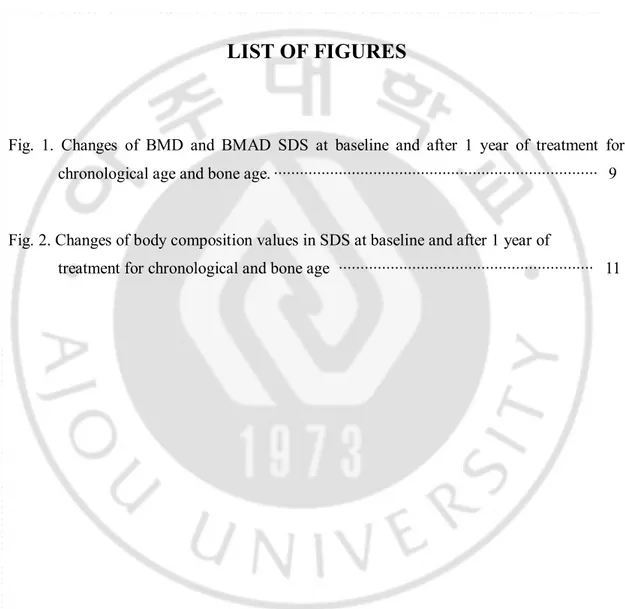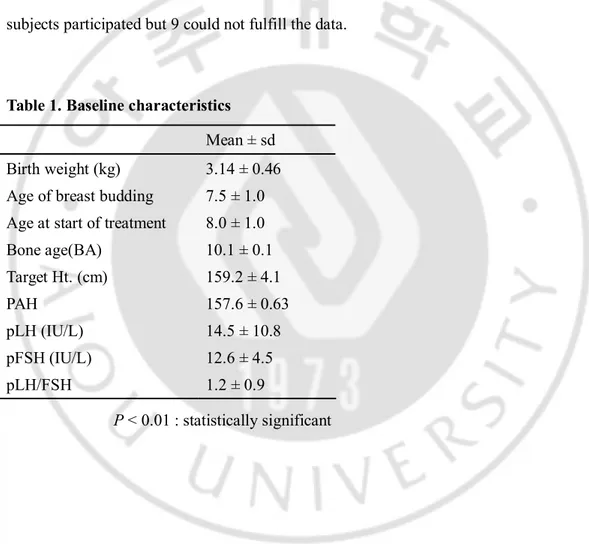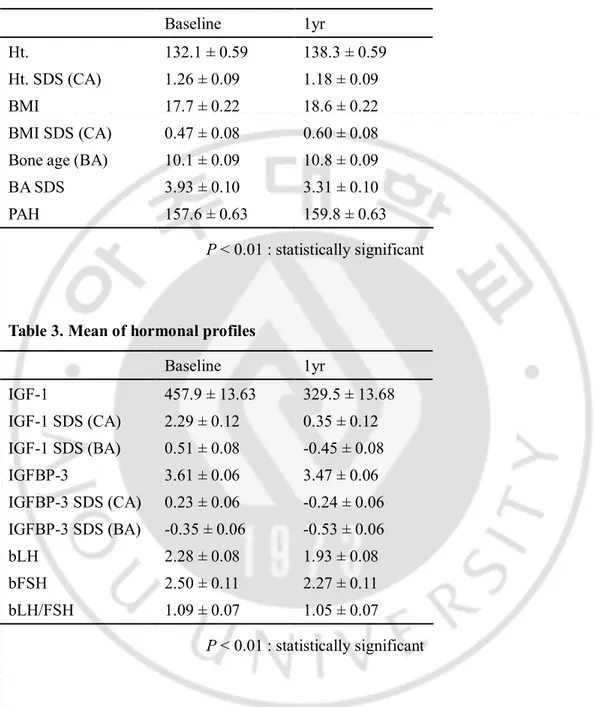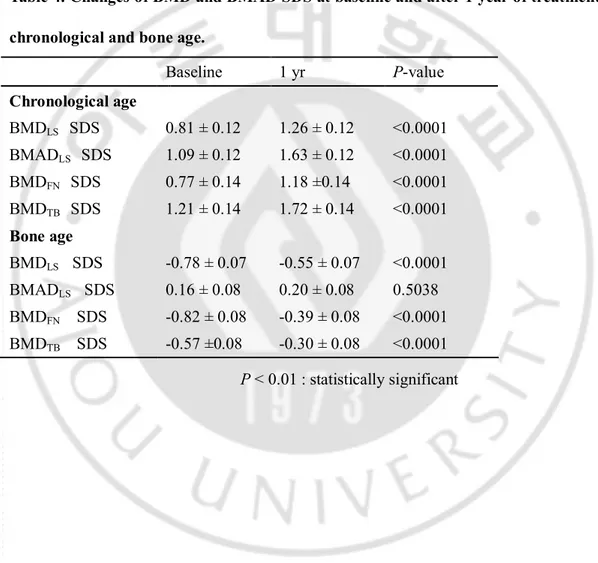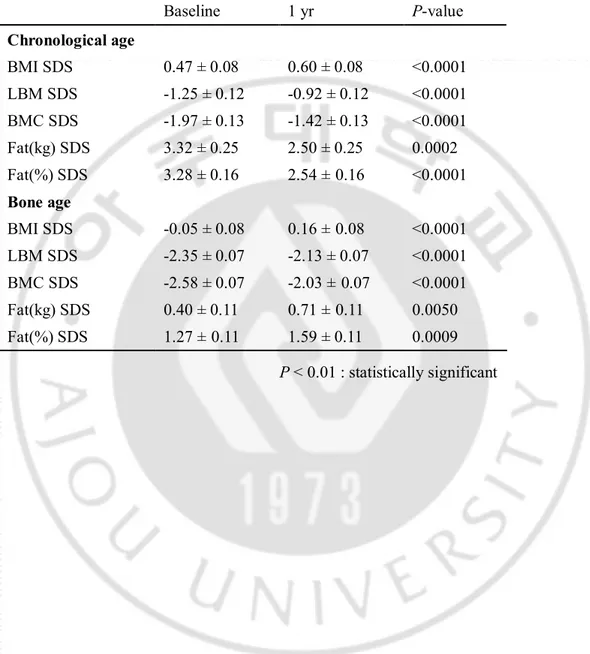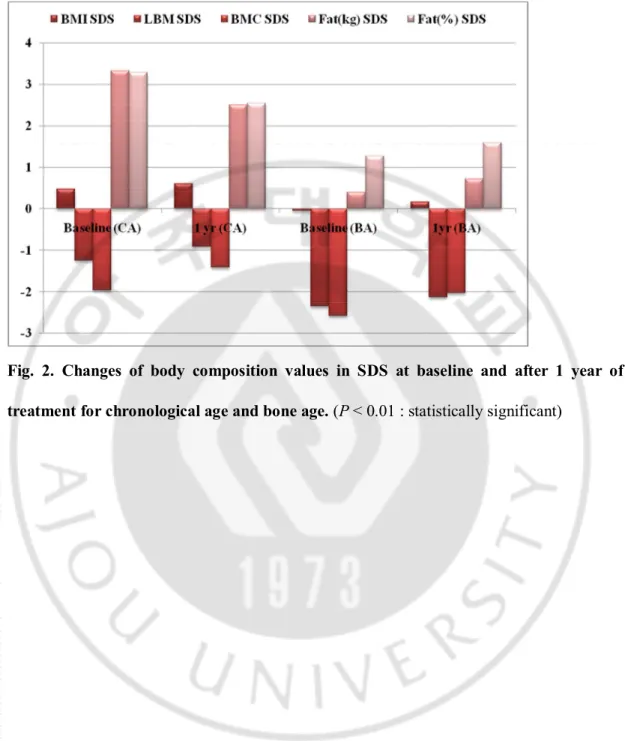저작자표시-비영리-변경금지 2.0 대한민국 이용자는 아래의 조건을 따르는 경우에 한하여 자유롭게 l 이 저작물을 복제, 배포, 전송, 전시, 공연 및 방송할 수 있습니다. 다음과 같은 조건을 따라야 합니다: l 귀하는, 이 저작물의 재이용이나 배포의 경우, 이 저작물에 적용된 이용허락조건 을 명확하게 나타내어야 합니다. l 저작권자로부터 별도의 허가를 받으면 이러한 조건들은 적용되지 않습니다. 저작권법에 따른 이용자의 권리는 위의 내용에 의하여 영향을 받지 않습니다. 이것은 이용허락규약(Legal Code)을 이해하기 쉽게 요약한 것입니다. Disclaimer 저작자표시. 귀하는 원저작자를 표시하여야 합니다. 비영리. 귀하는 이 저작물을 영리 목적으로 이용할 수 없습니다. 변경금지. 귀하는 이 저작물을 개작, 변형 또는 가공할 수 없습니다.
Changes in BMD and Body Composition
in Children with Central Precocious Puberty
Before and After Treatment with GnRH Agonist
by
Jung Hee Ko
Major in Medicine
Department of Medical Sciences
The Graduate School, Ajou University
Changes in BMD and Body Composition
in Children with Central Precocious Puberty
Before and After Treatment with GnRH Agonist
by
Jung Hee Ko
A Dissertation Submitted to The Graduate School of Ajou University
in Partial Fulfillment of the Requirements for the Degree of
Master of Medicine
Supervised by
Jin Soon Hwang, M.D., Ph.D.
Major in Medicine
Department of Medical Sciences
The Graduate School, Ajou University
This certifies that the dissertation
of Jung Hee Ko is approved.
SUPERVISORY COMMITTEE
Jin Soon Hwang
Ki Soo Pai
Jo Won Jung
The Graduate School, Ajou University
December, 21st, 2009
i
– ABSTRACT –
Changes in BMD and Body Composition
in Children with Central Precocious Puberty
Before and After Treatment with GnRH Agonist
We assessed bone mineral density (BMD) and body composition in 121 Korean girls with central precocious puberty (CPP) before, during, and after 1 year of treatment with go-nadotropin-releasing hormone (GnRH) agonist. BMD, bone mineral content (BMC), lean body mass (LBM), and fat mass (FM) were measured at baseline and after 1 year of treat-ment with dual energy x-ray absorptiometry (DEXA) and were expressed as standard devia-tion scores (SDS). Bone age and biochemical and hormonal profiles were assessed at base-line, after 6 months and 1 year of treatment.
Mean BMC and LBM were significantly lower than zero at baseline while FM and per-cent body fat (% FM) were higher than zero at baseline for both chronological and bone age. After 1 year of treatment, the differences for chronological age were decreased while the differences for bone age were persisted. The BMD SDS of each region of interest (ROI) in-cluding lumbar spine for chronological age were significantly higher than zero at baseline and increased after 1 year of treatment, while BMD SDS for bone age was significantly lower than zero at baseline and increased after 1 year of treatment.
Girls with CPP showed high %FM before and after GnRH agonist treatment for both chronological and bone age. The risk of obesity seems to be started before GnRH agonist treatment. Through this study, we concluded that pituitary-gonadal axis suppression by GnRH agonist does not reverse the progression of bone mass acquisition in children with CPP.
ii
TABLE OF CONTENTS
ABSTRACT ··· i
TABLE OF CONTENTS ··· ii
LIST OF FIGURES ··· iii
LIST OF TABLES ··· iv
ABBREVIATION ··· v
I. INTRODUCTION ··· 1
II. SUBJECTS AND METHODS ··· 3
A. PATIENTS ··· 3
B. METHODS ··· 3
C. STATISTICS ··· 5
III. RESULTS ··· 6
A. POPULATION CHARACTERISTICS ··· 6
B. BONE MINERAL DENSITY CHANGES OF EACH REGION OF INTEREST ··· 7
C. BODY COMPOSITION CHANGES ··· 11
IV. DISCUSSION ··· 12
V. CONCLUSION ··· 16
REFERENCES ··· 17
iii
LIST OF FIGURES
Fig. 1. Changes of BMD and BMAD SDS at baseline and after 1 year of treatment for chronological age and bone age. ··· 9
Fig. 2. Changes of body composition values in SDS at baseline and after 1 year of
iv
LIST OF TABLES
Table 1. Baseline characteristics ··· 6
Table 2. Mean of anthropometry ··· 7
Table 3. Mean of hormonal profiles ··· 7
Table 4. Changes of BMD and BMAD SDS at baseline and after 1 year of treatment for chronological and bone age ··· 8
Table 5. Changes of body composition values in SDS at baseline and after 1 year of
v
ABBREVIATION
BMD : bone mineral density
BMAD : bone mineral apparent density BMC : bone mineral content
BMI : body mass index LBM : lean body mass FM : fat mass
%FM : percent body fat
GnRH : gonadotropin-releasing hormone DEXA : dual energy x-ray absorptiometry CPP : central precocious puberty
SDS : standard deviation score LS : lumbar spine
FN : femur neck TB : total body GH : growth hormone
IGF-1 : insulin-like growth factor-1
IGFBP-3 : insulin-like growth factor binding protein-3 ROI : region of interest
- 1 -
I. INTRODUCTION
Puberty is a period when children attain adult height, bone mass, secondary sexual characteristics including body composition and reproductive capability. Puberty is initiated when the hypothalamo-pituitary-gonadal axis is activated and pulsatile secretion of gonadotropin-releasing hormone (GnRH) reaches some threshold. Idiopathic central precocious puberty (CPP) is defined when the axis is activated before the age of 8 years in girls without organic lesion (Lee, 2003; Carel and Leger, 2008). CPP causes short stature in adult and abnormal body proportion due to premature fusion of long bone epiphyseal growth plates. Besides, other psychosocial problems and early menarche affect children with CPP. GnRH agonist has been used in the treatment of CPP since the mid-eighties as its suppressive effect on the pituitary-gonadal axis. GnRH agonist suppresses gonadotropin secretion by desensitizing the pituitary gonadotrophs, reducing the secretion of sex steroids and retarding pubertal progression (Kamp et al., 1991; Heger et al., 1999).
The effect of GnRH agonist on adult height and delaying sexual maturation is well established. However, much concern has been raised and unsolved about obesity and decrease of bone mineral density (BMD) after treatment with GnRH agonist (Song et al., 2005). GnRH agonist arrest puberty which is considered to be a crucial period for bone mass and lean body mass (LBM) acquisition. During puberty, girls show increment of fat mass which is related to estrogen levels. GnRH agonist suppresses growth hormone (GH) and insulin-like growth factor-1 (IGF-1) levels by decreasing estrogen levels, which might play a role in the increment of fat mass and decrement of LBM and bone mineral content (BMC)
- 2 -
(van der Sluis et al., 2002). Although the initial concern about decreasing BMD due to suppression of estrogen was solved by recent long-term follow up studies, there is not yet a comprehensive consensus of the effects of subsequent withdrawal of gonadal sex steroids on body composition and obesity in children with CPP (Paoletti et al., 1996).
In this study, we analyzed height, weight, BMI, BMD of each region of interest (ROI) and body composition by dual energy x-ray absorptiometry (DEXA), before and after 1 year of treatment with GnRH agonist. Body composition, especially fat mass is different depending on race and ethnicity. This is a first report on Asian children and differs from previous studies targeting only Caucasian children (Gallagher et al., 2000; Kagawa et al., 2006). Also, previous studies used DEXA in small numbers and mostly used BMI and skinfold thickness in assessing obesity which are not accurate and precise (Sweeting, 2007). The aim of this study was to assess BMD and body composition, especially %FM based on DEXA, before and after 1 year of treatment with GnRH agonist in Korean girls. This might be useful in identifying whether obesity in CPP is due to disease itself or secondary to treatment with GnRH agonist.
- 3 -
II. SUBJECTS AND METHODS
A. Patients
One hundred and twenty one Korean girls were enrolled in this study. Start of treatment with GnRH agonist was at a mean age of 8.0 ± 1.0 (range, 4.5-9yr). Main criteria for the diagnosis of CPP were secondary pubertal signs of breast budding before chronological age of 8 yr, accelerated growth velocity, advancement of bone age more than 1 yr above chorological age, and GnRH-stimulated serum luteinizing hormone (LH) concentration greater than 5 IU/L. Girls with known chronic disease including other endocrine disease (congenital adrenal hyperplasia, hypothyroidism, and brain lesion on MRI) or taking medications that would affect body composition were excluded. The Institutional Review Board of Hospital approved this study. Informed consent was obtained from all parents and subjects.
B. Methods
Pubertal stage was assessed according to Tanner (Tanner and Whitehouse, 1976). Bone age was estimated by the method of Greulich and Pyle (Greulich and Pyle, 1959) and predicted adult height was calculated according to the method of Bayley and Pinneau (Bayley and Pinneau, 1952). Bone ages were read by one pediatric endocrinologist. Weight was measured to the nearest 0.1 kg on electronic scale (150A, Cas co., Ltd., Seoul, Korea) and height was measured to the nearest 0.1cm using a stadiometer (Harpenden stadiometer, Dong Sahn Jenix Co., Ltd., Seoul, Korea). Whole body and regional DEXA scans were
- 4 -
performed using Lunar Prodigy advance with pediatric software version enCore 2005 9.15.010 (GE Lunar Corporation, General Electric, Madison, WI). Whole body scans provided BMC, LBM, FM, and %FM of each subject. Regional scan provided BMD at lumbar spine (L1~L4), femur neck (FN), and total body (TB). Bone mineral apparent density (BMAD) of lumbar spine was calculated with the model BMADLS = BMDLS x [4/( x
width)] (van der Sluis et al., 2002). Trained technician performed the measures based on manufacturer’s guideline including positioning.
Retrospective review of medical records was done. Standard deviation score (SDS) of height, body weight, and BMI was calculated on the reference of healthy Korean children and adolescents by the Korean Pediatric Society and Korea Centers for Disease Control and
Prevention in 2007. The SDS of each BMDLS, BMADLS, BMDFN, and BMDTB values were
calculated using data of healthy Korean girls (Lim et al., 2008). The SDS of each LBM, BMC, FM, and %FM values were calculated using data of healthy Korean girls (Lim et al., 2009). Also, SDS of IGF-1 and insulin-like growth factor binding protein-3 (IGFBP-3) were calculated based on healthy Korean girls. Anthropometry, assessment of biochemical and hormonal profiles and bone age were performed at baseline, after 6 months and 1 year.
GnRH stimulation test was performed by injecting 100μg of luteinizing hormone releasing hormone (LHRH) and measuring serum levels of LH and FSH at baseline, after 30, 45, 60, and 90 minutes by using immunoradiometric assay. Peak serum level of LH greater than 5 IU/L was considered to be pubertal response.
After the initial evaluation including auxological, DEXA and hormonal evaluation, subjects were treated with depot leuprolide-acetate 100μg/kg given sc every 4 weeks. An
- 5 -
untreated control group was not available in this study. Suppression of pituitary-gonadal function was evaluated by clinical evaluation and by measuring basal serum levels of LH, follicle-stimulating hormone (FSH), and estradiol (E2) every 6 months of treatment. The whole anthropometry, DEXA, bone age and hormonal evaluation were repeated after 1 year of treatment.
C. Statistics
Data are expressed as mean ± SD. One-sample t test was performed to compare the
mean SDS values with normal anthropometry, BMD, body composition and hormonal values. Paired t test was performed to compare the values at baseline and 1 year after GnRH agonist treatment. All statistical analysis was performed using SPSS 15.0 (SPSS, Chicago, IL, USA). In all analyses, P value < 0.05 was considered statistically significant.
- 6 -
III. RESULTS
A. Population characteristics
The baseline clinical characteristics are shown in Table 1. Mean of anthropometry and hormonal profiles at baseline and at 1 year are shown in Table 2 and Table 3. Initially 121 subjects participated but 9 could not fulfill the data.
Table 1. Baseline characteristics Mean ± sd
Birth weight (kg) 3.14 ± 0.46
Age of breast budding 7.5 ± 1.0
Age at start of treatment 8.0 ± 1.0
Bone age(BA) 10.1 ± 0.1 Target Ht. (cm) 159.2 ± 4.1 PAH 157.6 ± 0.63 pLH (IU/L) 14.5 ± 10.8 pFSH (IU/L) 12.6 ± 4.5 pLH/FSH 1.2 ± 0.9 P < 0.01 : statistically significant
- 7 -
Table 2. Mean of anthropometry
Baseline 1yr
Ht. 132.1 ± 0.59 138.3 ± 0.59
Ht. SDS (CA) 1.26 ± 0.09 1.18 ± 0.09
BMI 17.7 ± 0.22 18.6 ± 0.22
BMI SDS (CA) 0.47 ± 0.08 0.60 ± 0.08
Bone age (BA) 10.1 ± 0.09 10.8 ± 0.09
BA SDS 3.93 ± 0.10 3.31 ± 0.10
PAH 157.6 ± 0.63 159.8 ± 0.63
P < 0.01 : statistically significant
Table 3. Mean of hormonal profiles
Baseline 1yr IGF-1 457.9 ± 13.63 329.5 ± 13.68 IGF-1 SDS (CA) 2.29 ± 0.12 0.35 ± 0.12 IGF-1 SDS (BA) 0.51 ± 0.08 -0.45 ± 0.08 IGFBP-3 3.61 ± 0.06 3.47 ± 0.06 IGFBP-3 SDS (CA) 0.23 ± 0.06 -0.24 ± 0.06 IGFBP-3 SDS (BA) -0.35 ± 0.06 -0.53 ± 0.06 bLH 2.28 ± 0.08 1.93 ± 0.08 bFSH 2.50 ± 0.11 2.27 ± 0.11 bLH/FSH 1.09 ± 0.07 1.05 ± 0.07 P < 0.01 : statistically significant
B. Bone mineral density changes of each region of interest
The results of BMD before and after 1 year of GnRH agonist treatment are shown in
Table 4. BMDLS, BMDFN, BMDTB, and BMADLS SDS for chronological age were
- 8 -
BMDLS, BMDFN, and BMDTB for bone age were significantly lower than zero at baseline and
decreased the gab after 1 year of treatment. The BMD of each ROI for both chronological age and bone age increased after 1 year of treatment. (Fig.1)
Table 4. Changes of BMD and BMAD SDS at baseline and after 1 year of treatment for chronological and bone age.
Baseline 1 yr P-value Chronological age BMDLS SDS 0.81 ± 0.12 1.26 ± 0.12 <0.0001 BMADLS SDS 1.09 ± 0.12 1.63 ± 0.12 <0.0001 BMDFN SDS 0.77 ± 0.14 1.18 ±0.14 <0.0001 BMDTB SDS 1.21 ± 0.14 1.72 ± 0.14 <0.0001 Bone age BMDLS SDS -0.78 ± 0.07 -0.55 ± 0.07 <0.0001 BMADLS SDS 0.16 ± 0.08 0.20 ± 0.08 0.5038 BMDFN SDS -0.82 ± 0.08 -0.39 ± 0.08 <0.0001 BMDTB SDS -0.57 ±0.08 -0.30 ± 0.08 <0.0001 P < 0.01 : statistically significant
- 9 -
Fig. 1. Changes of BMD and BMAD SDS at baseline and after 1 year of treatment for chronological age and bone age. (P < 0.01 : statistically significant)
C. Body composition changes
The values of body composition before and after treatment are shown in Table 5. The mean BMI was slightly increased for both chronological and bone age. The FM and %FM for both chronological and bone age were significantly higher than zero at baseline. After GnRH agonist treatment, FM and %FM decreased for CA, but increased for BA. The LBM and BMC for both chronological and bone age were significantly lower than zero at baseline and increased after 1 year of treatment (Fig. 2). The prevalence of obesity before and after treatment was not different based on both BMI and %FM SDS.
- 10 -
Table 5. Changes of Body composition values in SDS at baseline and after 1 year of treatment for chronological and bone age.
Baseline 1 yr P-value Chronological age BMI SDS 0.47 ± 0.08 0.60 ± 0.08 <0.0001 LBM SDS -1.25 ± 0.12 -0.92 ± 0.12 <0.0001 BMC SDS -1.97 ± 0.13 -1.42 ± 0.13 <0.0001 Fat(kg) SDS 3.32 ± 0.25 2.50 ± 0.25 0.0002 Fat(%) SDS 3.28 ± 0.16 2.54 ±0.16 <0.0001 Bone age BMI SDS -0.05 ± 0.08 0.16 ±0.08 <0.0001 LBM SDS -2.35 ± 0.07 -2.13 ± 0.07 <0.0001 BMC SDS -2.58 ± 0.07 -2.03 ±0.07 <0.0001 Fat(kg) SDS 0.40 ± 0.11 0.71 ±0.11 0.0050 Fat(%) SDS 1.27 ±0.11 1.59 ± 0.11 0.0009 P < 0.01 : statistically significant
- 11 -
Fig. 2. Changes of body composition values in SDS at baseline and after 1 year of treatment for chronological age and bone age. (P < 0.01 : statistically significant)
- 12 -
IV. DISCUSSION
In this study, we found that the prevalence of obesity in Korean girls with CPP based on %FM was significantly high but not based on BMI at the baseline. Obesity is defined as
BMI ≥ 2SD based on Korean reference data or %FM ≥ 2SD. The treatments with GnRH
agonist did not affect prevalence of obesity based on %FM. We also found that BMD of each ROI for chronological age were higher than zero, but BMD of each ROI for bone age were lower than zero at baseline and decreased the gab after GnRH agonist treatment.
Girls with CPP were high in %FM compared to the reference group for both chronological and bone age. They were not obese based on BMI. Only 6 out of 112 were obese based on BMI SDS. However, %FM SDS for chronological age was 3.28 ± 0.16 and 1.27 ± 0.11 for bone age. The prevalence of obesity based on %FM for chronological age was 85 out of 112 and 27 out of 112 for bone age.
Clinically BMI is used for definition of overweight and obesity because it is simple and practical for large scale study. But BMI is inaccurate and less precise that BMI cannot distinguish lean body mass and adipose tissue, so one needs to be aware of its limitations as an indirect measure of adiposity (Sweeting, 2007). Compared to BMI, DEXA was also done validation studies with other reference methods and known to have good accuracy and reproducibility in pediatric populations (Gutin et al., 1996; Fuller et al., 2001; Sopher et al., 2004). This observation might explain the discrepancy of high prevalence of obesity in some ethnic group and not in others. The BMI based obesity rate in children with CPP was low in some groups (Glab et al., 2009) and high in others (Palmert et al., 1998; Paterson et al.,
- 13 -
2004).
The evidence published to date suggests that obesity may be causally related to earlier puberty in girls rather than that earlier puberty causes an increase in body fat. The discovery of the protein leptin provided a molecular basis for the suspected link between body fat stores and the timing of puberty through direct effects on gonadotropin secretion (DiVall and Radovick, 2009). However, it is possible that the early pubertal girls produce enough
gonadal steroids to result in greater body fat than would be found in age-matched prepubertal girls (Kaplowitz, 2008).
There is debate whether BMI increase or decrease during and after GnRH agonist treatment. The decreased GH and IGF-1 levels accompanied by GnRH agonist treatment might contribute to the increment of fat mass and decrease in LBM. GH deficient patients have decreased bone density, increased fat mass, and decreased LBM, which improved during GH replacement therapy (Kamp et al., 1991; Boot et al., 1997). Decreased estrogens promote deposition of fat in peripheral adipose tissue preventing the storage of excess calories as fat. Some studies reported a significant increase in body fat during the treatment period (Palmert et al., 1999; Paterson et al., 2004; Traggiai et al., 2005) while others even reported a reduction during the treatment period (Arrigo et al., 2004). Boot et el. reported body composition similar to those seen in patients with GH deficiency, that is, LBM SDS decreasing and FM and %FM SDS increasing during the treatment (Boot et al., 1998). However, in successive follow up, they also reported later that percentage body fat decreased and normalized within 1 year after cessation of treatment (van der Sluis et al., 2002). Heger et el. also reported that long term depot GnRH agonist (triptorelin) treatment in girls with
- 14 -
CPP had not aggravated obesity (Heger et al., 1999).
In this study, BMI increased but remained in the same SDS during GnRH agonist treatment. Furthermore, patients who were obese according to %FM SDS ended with the same %FM SDS position as at the beginning. Thus in this study, GnRH agonist treatment did not result in a significant increase of obesity as previously reported. One interesting finding is that FM SDS and %FM SDS decreased for chronological age, but increased for bone age after GnRH agonist treatment, which necessitates further study.
In this study, the BMD of each ROI including BMDLS for both chronological and bone
age increased after 1 year of treatment. In adults, GnRH agonist treatment has been reported to cause an absolute decrease in BMD (Paoletti et al., 1996). However, recent long-term study showed that GnRH agonist had no negative effect on BMD in healthy children and
absolute BMD kept increasing as puberty progresses. They concluded BMDLS decreased but
BMDTB and BMADLS showed no significant changes during treatment. 2 years after
cessation of therapy, BMD SDS of each ROI for chronological age and bone age did not differ from normal (van der Sluis et al., 2002). Heger et el. also concluded that long term depot GnRH agonist treatment had no negative effect on BMD and reproductive function in girls with CPP (Heger et al., 1999). However, some reported decrement in absolute
volumetric density (BMAD) levels, in SDS for chronological and bone age in girls with CPP after 2 years of treatment with GnRH agonist (triptorelin) (Antoniazzi et al., 1999).
In children, bone mineral acquisition is influenced by GH and IGF-1. In normal
pubertal development, the rise of circulating estradiol levels is associated with an increase of the amplitude of GH secretory pulses followed by an increase of IGF-1 circulating levels.
- 15 -
Synergistic actions of sex steroids, GH, and IGF-1 are amplified as they control growth, increase muscle mass and affect bone mineralization (Caufriez, 1997; Antoniazzi et al., 1999). In our study, IGF-1 level was relatively decreased due to lack of amplifying action of estradiol on the neuroendocrine regulation of pulsatile GH release during treatment with GnRH agonist. However, net IGF-1 level was enough to increase LBM and BMC. Through this study, we concluded that pituitary-gonadal axis suppression by GnRH agonist does not reverse the progression of bone mass acquisition in children with CPP.
- 16 -
V. CONCLUSION
This study is the first analysis of body composition of East Asian children with CPP. Most of the previous studies were undertaken mainly on whites and compared with whites without considering diverse Asian ethnic differences. Asian adult are known to have different body composition including body fat compared to other race and it must have been started from childhood (Ehtisham et al., 2005; Shaw et al., 2007).
We found that girls with CPP, possibly Asian girls are not obese based on BMI but prevalence of obesity is high based on %FM. We also found treatments with GnRH agonist do not affect prevalence of obesity based on %FM. The %FM SDS persists during treatments with GnRH agonist. The BMD of each ROI for chronological age were higher but lower than zero for bone age at baseline and decreased the gab after GnRH agonist treatment. In this 1 year follow up study, treatments with GnRH agonist did not show negative effect on BMD of each ROI, but long-term follow up study is needed whether treatments of GnRH agonist affect adult BMD and obesity.
- 17 -
REFERENCES
1. Antoniazzi F, Bertoldo F, Lauriola S, Sirpresi S, Gasperi E, Zamboni G, Tato L: Prevention of bone demineralization by calcium supplementation in precocious puberty during gonadotropin-releasing hormone agonist treatment. J Clin Endocrinol Metab 84: 1992-1996, 1999
2. Arrigo T, De Luca F, Antoniazzi F, Galluzzi F, Segni M, Rosano M, Messina MF, Lombardo F: Reduction of baseline body mass index under gonadotropin-suppressive therapy in girls with idiopathic precocious puberty. Eur J Endocrinol 150: 533-537, 2004
3. Bayley N, Pinneau SR: Tables for predicting adult height from skeletal age: revised for use with the Greulich-Pyle hand standards. J Pediatr 40: 423-441, 1952
4. Boot AM, De Muinck Keizer-Schrama S, Pols HA, Krenning EP, Drop SL: Bone mineral density and body composition before and during treatment with gonadotropin-releasing hormone agonist in children with central precocious and early puberty. J Clin Endocrinol Metab 83: 370-373, 1998
5. Boot AM, Engels MA, Boerma GJ, Krenning EP, De Muinck Keizer-Schrama SM: Changes in bone mineral density, body composition, and lipid metabolism during growth hormone (GH) treatment in children with GH deficiency. J Clin Endocrinol Metab 82: 2423-2428, 1997
6. Carel JC, Leger J: Clinical practice. Precocious puberty. N Engl J Med 358: 2366-2377, 2008
7. Caufriez A: The pubertal spurt: effects of sex steroids on growth hormone and insulin-like growth factor I. Eur J Obstet Gynecol Reprod Biol 71: 215-217, 1997
- 18 -
Diabetes Obes 16: 1-4, 2009
9. Ehtisham S, Crabtree N, Clark P, Shaw N, Barrett T: Ethnic differences in insulin resistance and body composition in United Kingdom adolescents. J Clin Endocrinol Metab 90: 3963-3969, 2005
10. Fuller NJ, Wells JC, Elia M: Evaluation of a model for total body protein mass based on dual-energy X-ray absorptiometry: comparison with a reference four-component model. Br J Nutr 86: 45-52, 2001
11. Gallagher D, Heymsfield SB, Heo M, Jebb SA, Murgatroyd PR, Sakamoto Y: Healthy percentage body fat ranges: an approach for developing guidelines based on body mass index. Am J Clin Nutr 72: 694-701, 2000
12. Glab E, Barg E, Wikiera B, Grabowski M, Noczynska A: Influence of GnRH analog therapy on body mass in central precocious puberty. Pediatr Endocrinol Diabetes Metab 15: 7-11, 2009
13. Greulich WW, Pyle SI: Radiographic atlas of skeletal development of the hand and wrist 2nd. Stanford, Calif.,, Stanford University Press, 1959
14. Gutin B, Litaker M, Islam S, Manos T, Smith C, Treiber F: Body-composition measurement in 9-11-y-old children by dual-energy X-ray absorptiometry, skinfold-thickness measurements, and bioimpedance analysis. Am J Clin Nutr 63: 287-292, 1996 15. Heger S, Partsch CJ, Sippell WG: Long-term outcome after depot gonadotropin-releasing
hormone agonist treatment of central precocious puberty: final height, body proportions, body composition, bone mineral density, and reproductive function. J Clin Endocrinol Metab 84: 4583-4590, 1999
16. Kagawa M, Kerr D, Uchida H, Binns CW: Differences in the relationship between BMI and percentage body fat between Japanese and Australian-Caucasian young men. Br J Nutr 95: 1002-1007, 2006
- 19 -
17. Kamp GA, Manasco PK, Barnes KM, Jones J, Rose SR, Hill SC, Cutler GB, Jr.: Low growth hormone levels are related to increased body mass index and do not reflect impaired growth in luteinizing hormone-releasing hormone agonist-treated children with precocious puberty. J Clin Endocrinol Metab 72: 301-307, 1991
18. Kaplowitz PB: Link between body fat and the timing of puberty. Pediatrics 121: S208-S217, 2008
19. Lee MM: Is treatment with a luteinizing hormone-releasing hormone agonist justified in short adolescents? New England Journal of Medicine 348: 942-945, 2003
20. Lim JS, Hwang JS, Cheon GJ, Lee JA, Kim DH, Park KD, Yi KH: Gender differences in total and regional body composition changes as measured by dual-energy x-ray absorptiometry in Korean children and adolescents. J Clin Densitom 12: 229-237, 2009 21. Lim JS, Hwang JS, Park KD, Cheon GJ, Shin CH, Yang SW: Bone Mineral Density
According to Age, Bone Age, Pubertal Stages in Korean Children and Adolescents. Hormone Research 70: 26-26, 2008
22. Palmert MR, Mansfield MJ, Crowley WF, Jr., Crigler JF, Jr., Crawford JD, Boepple PA: Is obesity an outcome of gonadotropin-releasing hormone agonist administration? Analysis of growth and body composition in 110 patients with central precocious puberty. J Clin Endocrinol Metab 84: 4480-4488, 1999
23. Palmert MR, Radovick S, Boepple PA: The impact of reversible gonadal sex steroid suppression on serum leptin concentrations in children with central precocious puberty. J Clin Endocrinol Metab 83: 1091-1096, 1998
24. Paoletti AM, Serra GG, Cagnacci A, Vacca AM, Guerriero S, Solla E, Melis GB: Spontaneous reversibility of bone loss induced by gonadotropin-releasing hormone analog treatment. Fertil Steril 65: 707-710, 1996
- 20 -
25. Paterson WF, McNeill E, Young D, Donaldson MD: Auxological outcome and time to menarche following long-acting goserelin therapy in girls with central precocious or early puberty. Clin Endocrinol (Oxf) 61: 626-634, 2004
26. Shaw NJ, Crabtree NJ, Kibirige MS, Fordham JN: Ethnic and gender differences in body fat in British schoolchildren as measured by DXA. Arch Dis Child 92: 872-875, 2007 27. Song AK, Kim HJ, Suk HJ, Hwang JS, Hong CH: Serum IGF-I and IGFBP-3 in 919
Healthy Korean Children and Adolescents : Normal Values and Correlation with Age, Sex, Height, Body Mass Index and Bone Age. Journal of Korean Society of Pediatric Endocrinology 10: 35-41, 2005
28. Sopher AB, Thornton JC, Wang J, Pierson RN, Jr., Heymsfield SB, Horlick M: Measurement of percentage of body fat in 411 children and adolescents: a comparison of dual-energy X-ray absorptiometry with a four-compartment model. Pediatrics 113: 1285-1290, 2004
29. Sweeting HN: Measurement and definitions of obesity in childhood and adolescence: a field guide for the uninitiated. Nutr J 6: 32, 2007
30. Tanner JM, Whitehouse RH: Clinical longitudinal standards for height, weight, height velocity, weight velocity, and stages of puberty. Arch Dis Child 51: 170-179, 1976 31. Traggiai C, Perucchin PP, Zerbini K, Gastaldi R, De Biasio P, Lorini R: Outcome after
depot gonadotrophin-releasing hormone agonist treatment for central precocious puberty: effects on body mass index and final height. Eur J Endocrinol 153: 463-464, 2005
32. van der Sluis IM, Boot AM, Krenning EP, Drop SL, De Muinck Keizer-Schrama SM: Longitudinal follow-up of bone density and body composition in children with precocious or early puberty before, during and after cessation of GnRH agonist therapy. J Clin Endocrinol Metab 87: 506-512, 2002
- 21 - – 국문요약 –
GnRH agonist로 치료한 특발성 진성 성조숙증 여아에서
치료전과 치료 1년 후에 DEXA로 측정한
골밀도와 체성분의 변화
아주대학교 대학원의학과 고 정 희 (지도교수 : 황 진 순) 특발성 진성 성조숙증 여아에서 생식샘자극호르몬분비호르몬유도체(Gonadotropin releasing hormone agonist, GnRH agonist)로 치료할 경우 비만을 유발하고 골밀도가 감소할 우려가 있다고 지적되어 왔다. 본 연구자는 상기 환아들에서 GnRH agonist로 치료전과 치료 1년 후에 이중 에너지 X선 흡수법(dual energy X-ray absorptiometry, DEXA)으로 골밀도와 체성분을 측정하여 변화를 보고자 하였다. 2007년 1월부터 2009년 3월까지 아주대학교 병원 소아청소년과에서 특발성 진성 성조숙증으로 진단받고, Depot leuprolide acetate로 치료한 121명의 여자 환자를 대상으로 하였다. 치료전과 치료 1년 후에 DEXA를 시행하여, 골밀도와 체성분을 조사하였고, 신장과 체중 측정, 골연령, 생화학 검사와 호르몬 검사를 6개월마다 시행하였다.
- 22 -
BMD) 표준편차점수(standard deviation score, SDS), 요추부 부피
골밀도(bone mineral apparent density, BMAD) SDS, 대퇴골 경부 BMD SDS, 전신 BMD SDS는 0보다 높았으나 골연령에 대비해서는 0보다 낮았다. 1년간 치료 후, 역연령과 골연령 대비 모든 BMD SDS는 통계적으로 유의하게 증가하였다. 역연령 및 골연령 대비 제지방량과 골량의 SDS 는 치료 전 0보다 작은 값을 보였고, 체지방과 체지방율의 SDS 는 치료 전 0보다 큰 값을 보였다. 치료 1년 뒤 역연령 대비하여 SDS 변화량은 감소하였고, 골연령 대비해서는 변화없었다. 특발성 진성 성조숙증 여아에서 1년동안 GnRH agonist 로 치료한 결과 골밀도를 감소시키지 않았으며, 비만의 가능성을 높이지 않은 것을 확인할 수 있었지만 장기간의 추적관찰 및 대조군 설정을 통한 보다 정확한 연구가 진행될 필요가 있겠다. 핵심어 : 특발성 진성 성조숙증, 생식샘자극호르몬분비호르몬 유도체, 골밀도, 체성분, 이중에너지 X선 흡수법
